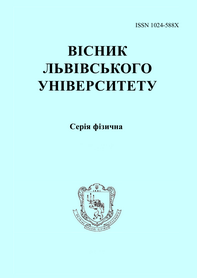DOI: https://doi.org/10.30970/vph.58.2021.39
THE DEPRESSION EFFECT IN SOLAR AND STELLAR CONTINUOUS SPECTRA
M. Vavrukh, O. Stelmakh, D. Dzikovskyi

| Visnyk of the Lviv University. Series Physics
58 (2021) с. 39-49
DOI: https://doi.org/10.30970/vph.58.2021.39 THE DEPRESSION EFFECT IN SOLAR AND STELLAR CONTINUOUS SPECTRAM. Vavrukh, O. Stelmakh, D. Dzikovskyi |  |
In this paper we outline the main relations of quantum mechanical approach to description of collision processes of photons with microparticles of solar-type stellar atmospheres. Here, the main process of continuous absorption coefficient formation is the process of photoionization of negative hydrogen ions H-. We have proposed hypothesis, which generalize Wildt's hypothesis \cite{wildt_1939, wildt_1941}, in order to obtain the agreement of the results of a laboratory experiment with theoretical calculation. We assumed that authors of work\cite{smit_burch_1959} measured not the partial cross section of ion H- photoionization, but some effective cross section \sigmaeff(\lambda), formed by three low-energy processes: photoionization of ion H-, photoionization of neutral hydrogen atoms excited to the level with the main quantum number n\geq3, and photon absorption by ``free'' electrons. In the region \lambda\lambda (6500 -- 8200) \AA the effect of photon absorption by ``free'' electrons is negligible. The effective cross section \sigmaeff(\lambda) calculated for the model, which takes into account the photoionization of ions H- and hydrogen atoms from states n=3 and 4, agree with the results of the work of Smith and Burch. In the model of the one-dimensional Aller atmosphere it was investigated spectral properties of absorption continuous coefficient and radiation intensity of the center of solar disk. The calculation results with high accuracy coincide with the observation results from works \cite{Burlov1998, Labs1968}. Large-scale depression of intensity was revealed in the region \lambda\lambda (6500 -- 8200) \AA which is determined by the difference between the radiation intensity for a completely black body and the calculated / measured intensity of the center of the solar disk. The relative value of depression has order 2\div2.5\% in the middle of the specified wavelength interval. It was substantiated the possibility of manifestation of depression effect in radiation of other stars, in particular those belonging to the spectral classes A-G. Based on data on the spectral intensity of stars from the catalog \cite{Komarova_1995} the effect of depression was revealed in some stars of classes A, F, G, belonging to the main sequence, sub-giants and giants. The perspective of expanding the search for the effect of depression in the spectra of stars seems to be an urgent task for observers and theorists. %